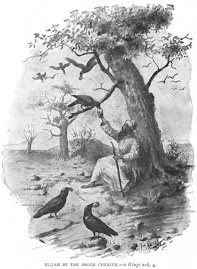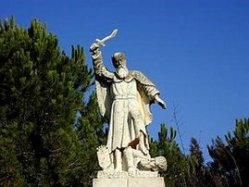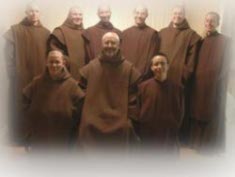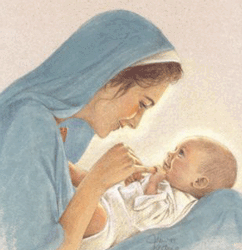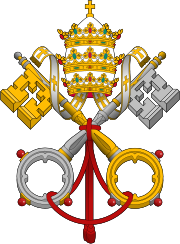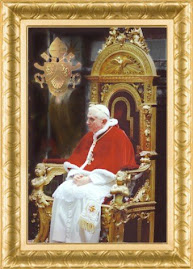...[T]he scholastic Doctors have recognized the Assumption of the Virgin Mother of God as something signified, not only in various figures of the Old Testament, but also in that woman clothed with the sun whom John the Apostle contemplated on the Island of Patmos (Rev 12:1). Similarly they have given special attention to these words of the New Testament: "Hail, full of grace, the Lord is with you, blessed are you among women,"(Lk 1:28) since they saw, in the mystery of the Assumption, the fulfillment of that most perfect grace granted to the Blessed Virgin and the special blessing that countered the curse of Eve....
....Among the holy writers who at that time employed statements and various images and analogies of Sacred Scripture to Illustrate and to confirm the doctrine of the Assumption, which was piously believed, the Evangelical Doctor, St. Anthony of Padua, holds a special place. On the feast day of the Assumption, while explaining the prophet's words: "I will glorify the place of my feet"(Is 61:13) he stated it as certain that the divine Redeemer had bedecked with supreme glory his most beloved Mother from whom he had received human flesh. He asserts that "you have here a clear statement that the Blessed Virgin has been assumed in her body, where was the place of the Lord's feet. Hence it is that the holy Psalmist writes: 'Arise, O Lord, into your resting place: you and the ark which you have sanctified."' And he asserts that, just as Jesus Christ has risen from the death over which he triumphed and has ascended to the right hand of the Father, so likewise the ark of his sanctification "has risen up, since on this day the Virgin Mother has been taken up to her heavenly dwelling."(St Anthony of Padua, Sermons)...
....When, during the Middle Ages, scholastic theology was especially flourishing, St. Albert the Great who, to establish this teaching, had gathered together many proofs from Sacred Scripture, from the statements of older writers, and finally from the liturgy and from what is known as theological reasoning, concluded in this way: "From these proofs and authorities and from many others, it is manifest that the most blessed Mother of God has been assumed above the choirs of angels. And this we believe in every way to be true."(St Albert the Great, Mariale). And, in a sermon which he delivered on the sacred day of the Blessed Virgin Mary's annunciation, explained the words "Hail, full of grace"- words used by the angel who addressed her-the Universal Doctor, comparing the Blessed Virgin with Eve, stated clearly and incisively that she was exempted from the fourfold curse that had been laid upon Eve (St Albert the Great, Sermons)...
....Following the footsteps of his distinguished teacher, the Angelic Doctor, despite the fact that he never dealt directly with this question, nevertheless, whenever he touched upon it, always held together with the Catholic Church, that Mary's body had been assumed into heaven along with her soul (St Thomas Aquinas, Sermons)....
....Along with many others, the Seraphic Doctor held the same views. He considered it as entirely certain that, as God had preserved the most holy Virgin Mary from the violation of her virginal purity and integrity in conceiving and in childbirth, he would never have permitted her body to have been resolved into dust and ashes (St Bonaventure, Sermons). Explaining these words of Sacred Scripture: "Who is this that comes up from the desert, flowing with delights, leaning upon her beloved?"(Songs 8:5) and applying them in a kind of accommodated sense to the Blessed Virgin, he reasons thus: "From this we can see that she is there bodily...her blessedness would not have been complete unless she were there as a person. The soul is not a person, but the soul, joined to the body, is a person. It is manifest that she is there in soul and in body. Otherwise she would not possess her complete beatitude"(St Bonaventure, Sermons)...
...In the fifteenth century, during a later period of scholastic theology, St. Bernardine of Siena collected and diligently evaluated all that the medieval theologians had said and taught on this question. He was not content with setting down the principal considerations which these writers of an earlier day had already expressed, but he added others of his own. The likeness between God's Mother and her divine Son, in the way of the nobility and dignity of body and of soul-a likeness that forbids us to think of the heavenly Queen as being separated from the heavenly King- makes it entirely imperative that Mary "should be only where Christ is."(St Bernardine of Siena, Sermons). Moreover, it is reasonable and fitting that not only the soul and body of a man, but also the soul and body of a woman should have obtained heavenly glory. Finally, since the Church has never looked for the bodily relics of the Blessed Virgin nor proposed them for the veneration of the people, we have a proof on the order of a sensible experience (ibid)...
....St. Francis of Sales, after asserting that it is wrong to doubt that Jesus Christ has himself observed, in the most perfect way, the divine commandment by which children are ordered to honor their parents, asks this question: "What son would not bring his mother back to life and would not bring her into paradise after her death if he could?" (St Francis de Sales, Sermons). And St. Alphonsus writes that "Jesus did not wish to have the body of Mary corrupted after death, since it would have redounded to his own dishonor to have her virginal flesh, from which he himself had assumed flesh, reduced to dust."(St Alphonsus Liquori, The Glories of Mary)...
....All these proofs and considerations of the holy Fathers and the theologians are based upon the Sacred Writings as their ultimate foundation. These set the loving Mother of God as it were before our very eyes as most intimately joined to her divine Son and as always sharing his lot. Consequently it seems impossible to think of her, the one who conceived Christ, brought him forth, nursed him with her milk, held him in her arms, and clasped him to her breast, as being apart from him in body, even though not in soul, after this earthly life. Since our Redeemer is the Son of Mary, he could not do otherwise, as the perfect observer of God's law, than to honor, not only his eternal Father, but also his most beloved Mother. And, since it was within his power to grant her this great honor, to preserve her from the corruption of the tomb, we must believe that he really acted in this way....
....It is to be hoped that all the faithful will be stirred up to a stronger piety toward their heavenly Mother, and that the souls of all those who glory in the Christian name may be moved by the desire of sharing in the unity of Jesus Christ's Mystical Body and of increasing their love for her who shows her motherly heart to all the members of this august body. And so we may hope that those who meditate upon the glorious example Mary offers us may be more and more convinced of the value of a human life entirely devoted to carrying out the heavenly Father's will and to bringing good to others. Thus, while the illusory teachings of materialism and the corruption of morals that follows from these teachings threaten to extinguish the light of virtue and to ruin the lives of men by exciting discord among them, in this magnificent way all may see clearly to what a lofty goal our bodies and souls are destined. Finally it is our hope that belief in Mary's bodily Assumption into heaven will make our belief in our own resurrection stronger and render it more effective....





